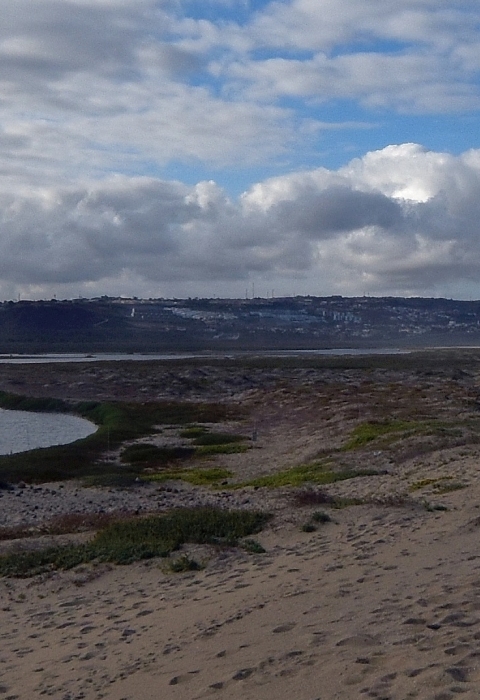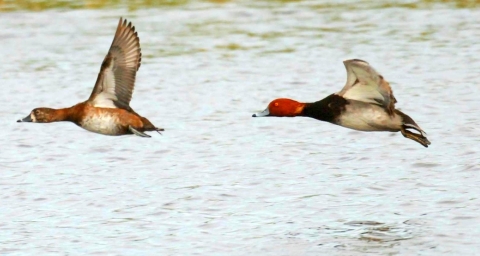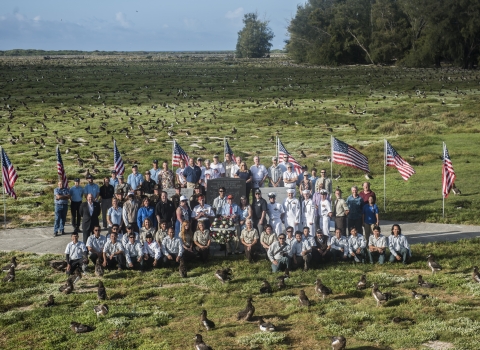Interstate 5 is the West Coast’s primary north-south highway. Considerably inland from the Pacific Ocean at most points, I-5 passes through major cities, yes, but also through verdant forests, majestic mountain passes and fertile river valleys.
It runs 1,381 miles from Blaine, Washington, on the Canadian border to San Ysidro, California, on the Mexican border.
This story presents a dozen-and-a-half national wildlife refuges between Seattle and San Diego where migratory birds often stop over along the Pacific Flyway and where weary I-5 travelers or even cyclists taking a similar path could take a short nature break.
Exit 114, Washington
A few years ago on the Fourth of July, Cea Dempsey of Tacoma, Washington, tweeted that nearby Billy Frank Jr. Nisqually National Wildlife Refuge along I-5 “is a perfect place to stop & stretch your legs. Vibrant summer green and full of #butterflies!”
Dempsey visited the refuge that day with her then-six-year-old son for a picnic and a walk.
Along a refuge trail, they saw frogs amid vegetation. “They were blending in. So we talked about camouflage,” she says. “You could smell all the flowers, and see all the birds. It was a lovely little day trip, a mini-adventure for us.”
If she were driving to Southern California, she can imagine stopping at other national wildlife refuges en route.
“Personally, I hate long drives," Dempsey says. "If I can break them up with a couple walks, then I’m happy.”
You can be, too.
Exit 14, Washington
Waterfowl-filled wetlands in the floodplain of the Columbia River and a dash of Native American culture make Ridgefield National Wildlife Refuge a great nature stop. The refuge, about four miles west of I-5 in Ridgefield, Washington, features an auto tour route open during daylight hours year-round and short walking trails open seasonally.
Exit 289, Oregon
Tualatin River National Wildlife Refuge, about six miles west of I-5, offers a one-mile nature trail open year-round, other trails open seasonally, a wetland observation deck and a river overlook. Its beautiful visitor center includes an exhibit hall, a classroom, a photo gallery, an outdoor education shelter, a cool bioswale and a nature store. A bioswale is a manmade, gently sloped, vegetation-filled depression designed to remove pollution from surface runoff water. The bioswale (in foreground in photo above) at Tualatin River National Wildlife Refuge absorbs runoff from the parking lot.
Exits 253, 243 & 209, Oregon
Jim Leonard is a regular visitor to and avid photographer at Ankeny National Wildlife Refuge, two miles west of I-5 Exit 243 in Oregon’s Willamette Valley.
“I enjoy setting up at Pintail Marsh at Ankeny and waiting for the wildlife to come to me,” says Leonard. He often sees bald eagles, American white pelicans and assorted duck species. “Each season brings a new variety of wildlife.”
To stretch your legs, try the one of several walking trails, including the Rail Trail boardwalk (above right) that winds through seasonally flooded woodlands.
Two other Willamette Valley national wildlife refuges are farther afield. Baskett Slough National Wildlife Refuge, 17 miles west of I-5 Exit 253, is ideal for nature photography. Its short trails and observation decks are open year-round, and two longer trails are open from April 1 to September 30. William L. Finley National Wildlife Refuge, 26 miles northwest of I-5 Exit 209, offers 12 miles of trails from which to observe or photograph wildlife. Eight historic barns and buildings provide a taste of the valley’s cultural history.
Exit 595, California
The six-mile auto tour at Sacramento National Wildlife Refuge is flush with waterfowl from late October until early February. On any given day more than 500,000 ducks and 200,000 geese can rest at the refuge.
“But if you stop by during November at sunset, you will have an experience you will never forget,” says former visitor services manager Lora Haller. “About 30 minutes after sunset, the hundreds of thousands of ducks and geese lift off the refuge to head to the surrounding agricultural land to feed on the remaining rice.”
The Sacramento National Wildlife Refuge visitor center is an information hub for four nearby refuges – Colusa, Sutter, Sacramento River and Delevan. Those refuges have differing recreational opportunities and opening hours.
Exit 504, California
In the heart of California along the Pacific Flyway, Stone Lakes National Wildlife Refuge attracts migratory birds from as far as the Arctic and South America.
“If I had one hour to spend at Stone Lakes, I would visit the Blue Heron Trails in the morning hours during winter migratory season to watch the visiting sandhill cranes or the thousands of waterfowl flying back and forth from the wetlands to the grasslands,” says visitor services manager Amy Hopperstad.
The universally accessible Blue Heron Trails are open dawn to dusk year-round. Dawn and dusk, by the way, are the best times of day to see wildlife at all national wildlife refuges, especially in the heat of summer.
Exits 449 & 403, California
Three national wildlife refuges are managed jointly from the beautiful San Luis National Wildlife Refuge Complex Visitor Center in Los Banos, California. Outdoor recreation planner Jack Sparks recommends the following for visitors:
- San Joaquin River National Wildlife Refuge, nine miles east of I-5 Exit 449, near Vernalis, California – Year-round, walk the four-mile Pelican Nature Trail, where you might see songbirds, raptors, coyotes, weasels, mink, otters, desert cottontail rabbits, black-tailed jackrabbits or endangered riparian riparian
Definition of riparian habitat or riparian areas.
Learn more about riparian brush rabbits. In fall and winter, visit the Beckwith observation platform, where tens of thousands of Aleutian cackling geese can be seen. - San Luis National Wildlife Refuge, 16 miles northeast of I-5 Exit 403 near Los Banos – In autumn and winter, drive the waterfowl tour route. Midway, walk to the Sousa Marsh Trail observation platform, where you can see thousands of ducks and geese and often some tundra swans. In spring and summer, walk the Woody Pond Trail and look for Bullock’s orioles, western kingbirds and numerous species of raptors. “Or beat the heat and drive around the elk tour route from the comfort of an air-conditioned car and view the herd of majestic tule elk,” Sparks says. The elks’ breeding rut, always a great show for visitors, starts in late July, he says.
- Merced National Wildlife Refuge, 28 miles northeast of I-5 Exit 403 – Make the auto tour route and Meadowlark Trail priorities. In fall and winter, Sparks says, “the sheer number of birds will overwhelm your senses of sight and sound.”
Exit 278, California
For a quick visit to Kern National Wildlife Refuge, deputy project leader Miguel Jimenez suggests driving the 6.5-mile Auto Route #1 and then walking the short Marsh Trail off Auto Route #2. Along the way, you might see dabbling ducks, diving ducks, shore birds, wading birds and raptors like eagles and hawks.
The refuge is open from sunrise to sunset. It is co-managed with Pixley National Wildlife Refuge.
Exits 8B & 4, California
At San Diego Bay National Wildlife Refuge, less than a mile off I-5 Exit 8B, former public information officer Lisa Cox, suggests walking the Bayside Birding and Walking Trail.
“It’s one of the most beautiful and tranquil spots to enjoy this neighborhood refuge," Cox says. "Plus, you might hear an endangered light-footed Ridgway’s rail [photo above], or see the famous flamingo visitor that still frequents the refuge.”
At Tijuana Slough National Wildlife Refuge, about three miles west of I-5 Exit 4, Cox recommends walking the beach to the mouth of the Tijuana River. There, coastal birds like pelicans and terns roost on little islands of sand rising above the tide, endangered California least terns dive for fish, and western snowy plovers skitter along searching for invertebrates to eat.
"You can also watch the surfers while checking out the stunning view of Mexico about a mile to the south,” Cox says.
Wherever you are along I-5, dress for the weather and keep in mind that pets often are not permitted at refuges because they can disturb wildlife and their habitat.
Happy travels!




















